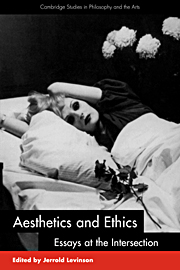Book contents
- Frontmatter
- Contents
- Editor's acknowledgments
- List of contributors
- 1 Introduction: aesthetics and ethics
- 2 Three versions of objectivity: aesthetic, moral, and scientific
- 3 Aesthetic value, moral value, and the ambitions of naturalism
- 4 On consistency in one's personal aesthetics
- 5 Art, narrative, and moral understanding
- 6 Realism of character and the value of fiction
- 7 The ethical criticism of art
- 8 How bad can good art be?
- 9 Beauty and evil: the case of Leni Riefenstahl's Triumph of the Will
- 10 The naked truth
- 11 Aesthetic derogation: hate speech, pornography, and aesthetic contexts
- Bibliography
- Index of names and titles
8 - How bad can good art be?
Published online by Cambridge University Press: 22 March 2010
- Frontmatter
- Contents
- Editor's acknowledgments
- List of contributors
- 1 Introduction: aesthetics and ethics
- 2 Three versions of objectivity: aesthetic, moral, and scientific
- 3 Aesthetic value, moral value, and the ambitions of naturalism
- 4 On consistency in one's personal aesthetics
- 5 Art, narrative, and moral understanding
- 6 Realism of character and the value of fiction
- 7 The ethical criticism of art
- 8 How bad can good art be?
- 9 Beauty and evil: the case of Leni Riefenstahl's Triumph of the Will
- 10 The naked truth
- 11 Aesthetic derogation: hate speech, pornography, and aesthetic contexts
- Bibliography
- Index of names and titles
Summary
Worries about the immorality of art can arise from a number of apparently quite different considerations. One line of thought, as old as Plato and as current as Catherine MacKinnon, emphasizes the continuity of art and life and contends that some artistic productions may corrupt the minds, hearts, and behavior of those who experience them.
Another concern, less historically pervasive perhaps but still potent, is grounded on an assumption that art is removed, or removes us, from life and thus from the strictures and obligations that properly bind us. This anxiety may stand as a vexed tribute to the cultural power of the doctrine of art for art's sake. It may be that Oscar Wilde's claim that “[a]ll art is quite useless” is granted, but the claim is treated as an anguished accusation and not a proud proclamation. Or one may believe, with Walter Pater, that “art comes to you proposing frankly to give nothing but the highest quality to your moments as they pass, and simply for those moments' sake,” and yet want to turn from such a proposal, as from the seductive allure of the lotus land, because one remembers that one has duties, that there are tasks to attend to in the passing moments of the responsible life. The separation of art and life is also delineated in accounts of “psychical distance” and of “the aesthetic attitude” and “disinterestedness,” and here again apprehension may arise that absorption in art can be defined in specific contrast to moral responsiveness.
- Type
- Chapter
- Information
- Aesthetics and EthicsEssays at the Intersection, pp. 204 - 226Publisher: Cambridge University PressPrint publication year: 1998
- 13
- Cited by

